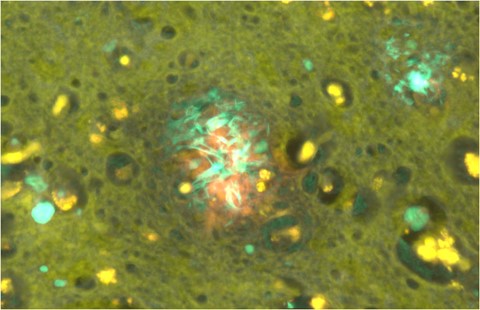20 January 2020

New research finds close association between high aluminum content and amyloid-beta
Amsterdam, NL – A new study published in the Journal of Alzheimer's Disease (JAD) supports a growing body of research that links human exposure to aluminum with Alzheimer's disease (AD). Researchers found significant amounts of aluminum content in brain tissue from donors with familial AD. The study also found a high degree of co-location with the amyloid-beta protein, which leads to early onset of the disease.
"This is the second study confirming significantly high brain accumulation in familial Alzheimer's disease, but it is the first to demonstrate an unequivocal association between the location of aluminum and amyloid-beta in the disease. It shows that aluminum and amyloid-beta are intimately woven in the neuropathology," explained lead investigator Christopher Exley, PhD, Birchall Centre, Lennard-Jones Laboratories, Keele University, Staffordshire, UK.
An association between aluminum and amyloid-beta has been suggested for over 40 years. In an earlier study, brain tissue from donors in the United Kingdom diagnosed with familial AD showed significant accumulations of aluminum. To further understand this relationship, in the current study the researchers measured aluminum in the brain tissue of a cohort of Colombian donors with familial AD who shared a specific mutation. The mutation leads to elevated levels of amyloid-beta, early disease onset, and an aggressive disease etiology. The levels were compared with a control set of brain tissues from donors with no diagnosis of neuropathological disease. They also used aluminum-specific fluorescence microscopy imaging to investigate the relationship between aluminum and amyloid-beta in familial AD.
The results were striking. The aluminum content of the brain tissue from donors with the genetic mutation was universally high, with 42% of tissues having a level considered pathologically significant, and the levels were significantly higher than those in the control set. The imaging studies identified aluminum deposits in all brain tissues studied. They were predominantly co-located with amyloid-beta in senile plaques and occasionally in the brain vasculature. Aluminum was also found separately from amyloid-beta in intracellular compartments including glia and neuronal axons. The results strongly suggest that genetic predispositions known to increase amyloid-beta in brain tissue also predispose individuals to accumulate and retain aluminum in brain tissue.
"Compelling localization of aluminum with a central player in AD, amyloid-beta, strengthens the link of aluminum to the pathogenesis of AD," commented George Perry, PhD, Professor of Biology, Semmes Distinguished University Chair in Neurobiology, University of Texas at San Antonio, and Editor-in-Chief of JAD.
"One could envisage increased amyloid-beta in brain tissue as a response to high levels of aluminum content, or that aluminum fosters the accumulation of amyloid-beta," said Dr. Exley. "Either way, the new research confirms my resolve that within the normal lifespan of humans, there would not be any AD if there were no aluminum in the brain tissue. No aluminum, no AD."

Caption: Amyloid-beta (green fluorescence) and aluminum (orange fluorescence) in
senile plaque from brain tissue of a familial Alzheimer's disease donor
###
NOTES FOR EDITORS
Full open access study: "Aluminum and Amyloid-β in Familial Alzheimer's Disease" by Matthew Mold, Caroline Linhart, Johana Gómez-Ramírez, Andres Villegas-Lanau, and Christopher Exley (DOI: 10.3233/JAD-191140) published in the Journal of Alzheimer’s Disease, online ahead of publication of Volume 73, Issue 4 (February 2020). It is openly available at: content.iospress.com/articles/journal-of-alzheimers-disease/jad191140.
Contact
For further information please contact Diana Murray, IOS Press (+1 718-640-5678 or d.murray@iospress.com). To reach the authors for comment please contact Christopher Exley (+44 1782 734080 or c.exley@keele.ac.uk) or the Keele Press Office (+44 1782 733857 / 734925 or news@keele.ac.uk). For questions about the Journal of Alzheimer’s Disease, please contact George Perry (+1 210-458-8660 or george.perry@utsa.edu).
About the Journal of Alzheimer's Disease
Now in its 23rd year of publication, the Journal of Alzheimer's Disease (JAD) is an international multidisciplinary journal to facilitate progress in understanding the etiology, pathogenesis, epidemiology, genetics, behavior, treatment, and psychology of Alzheimer's disease. The journal publishes research reports, reviews, short communications, book reviews, and letters-to-the-editor. Groundbreaking research that has appeared in the journal includes novel therapeutic targets, mechanisms of disease, and clinical trial outcomes. JAD has a Journal Impact Factor of 3.517 according to Journal Citation Reports (Web of Science Group, 2019) and is published by IOS Press. j-alz.com
About IOS Press
IOS Press is headquartered in Amsterdam with satellite offices in the USA, Germany, India and China and serves the information needs of scientific and medical communities worldwide. IOS Press now publishes more than 80 international peer-reviewed journals and about 75 book titles each year on subjects ranging from computer science, artificial intelligence, and engineering to medicine, neuroscience, and cancer research. iospress.com







